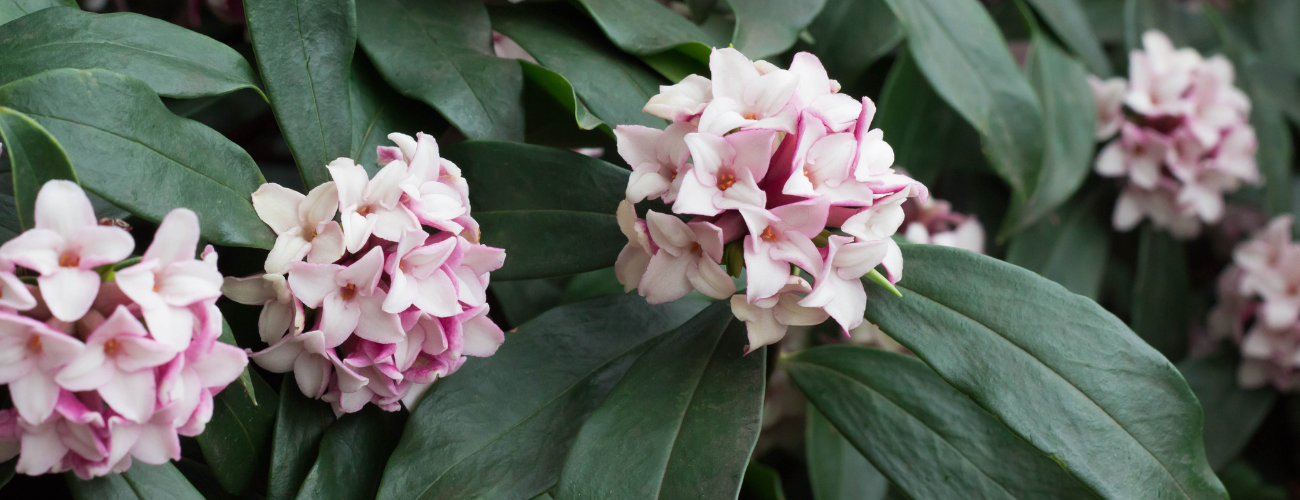You could be forgiven for thinking that there is nothing happening in the garden in winter but look closely and take a deep breath and you will see beautiful flowers and smell wonderful fragrances. But how to choose a top 5 when there are so many? I couldn’t, it was impossible, so I have chosen 12!
From largest to smallest:

Hamamelis, better known as witch hazel, is a scented winter flowering shrub with distinctive spidery shaped flowers covering the bare branches over a long period. The flowers shine out in the dull winter days and fill the air with a spicy fragrance. There are cultivars with flowers in shades of red, orange or yellow. Our favourite is ‘Arnold Promise’ a free flowering yellow variety with an RHS Award of Garden Merit. Looks stunning underplanted with Cyclamen coum and snowdrops.

Viburnum tinus ‘Eve Price’ is a medium sized shrub with glossy dark green leaves. In winter it is covered in profusions of white flower clusters with hints of pink. Very handy for a shady spot and will be almost drought tolerant once established.

Coronilla glauca ‘Variegata’ is a small shrub with pale green leaves margined in creamy-white and covered in yellow pea-like flowers. We have had some of these at South Downs Nurseries since autumn and they have been flowering continuously since then, even during the recent cold snap when temperatures dipped to -6’C every night for a week. It’s now February writing this and they are still flowering beautifully.

Clematis cirrhosa are hardy evergreen climbers with nodding flowers in pale white or pinks, often speckled. They provide essential pollen for any bees that emerge on a warm winters day. We recommend ‘Wisley Cream’ which flowers from January to March with nodding cream flowers and ‘Freckles’ with speckled pink flowers from November to February.

Daphne, to many, is the queen of winter fragrances. Daphne bholua and Daphne odora flower from late winter to herald the spring. Their small pinky-white flower clusters have an amazing scent that can stop you in your tracks.

Sarcococca are small evergreen shrubs with tiny white flowers. Like Daphne, those flowers pack a punch and from January you will be enthralled by their sweet scent. Plant by your front door to appreciate the fragrance every time you come and go.

Skimmia are wonderful cold season plants. Tight buds in clusters appear from autumn, last all through winter, and open into small starry flowers in spring. They have separate male and female plants. To get berries on the females in autumn you will need to plant a male variety nearby. They prefer acid soil so if you are on chalk plant in a pot.

Winter flowering heathers, such as Erica carnea or Erica darleyensis, are wonderful low growing plants. They flower for long periods in shades of pinks and white. Carnea tend to be more compact varieties and darleyensis have a looser growing habit. Although preferring more acidic soils, they are tolerant of lightly alkaline soils. They can also be grown in pots of ericaceous compost. They look wonderful en masse and, with careful choice of cultivars, you can have flowers all the way from early winter to late spring. Their nectar-rich flowers are also attractive to pollinators that emerge on a warm day to forage when other nectar sources are scarce.

Hellebores often called ‘Christmas roses’ are winter flowering perennials with elegant nodding flowers. Their flowers come in shades of pale green, white, cream or pinks, with the darkest being the colour of a fine claret wine. They love a shady spot. Hellebores have handsome evergreen foliage which can be cut back every winter to reveal the buds and flowers in their beauty. New foliage will grow in spring as the flowers fade. My favourite is ‘Winter Moonbeam’ for its beautiful marbled foliage and pinky-white flowers which glow in the low winter light.

Cyclamen coum are hardy tuberous perennials which spread wonderfully in shady spots under deciduous trees and shrubs. They have bright pink or white flowers which stand up above the foliage, often peaking out of a scattering of snow. They look wonderful when combined with …

… Snowdrops (Galanthus) are the harbingers of spring and the reminder that brighter days are on their way. They multiply forming drifts. They are happiest in woodland settings or under deciduous trees and shrubs where their little nodding bell-like flowers shine. They will even push themselves up through frozen snow-covered ground.

Pansies and Violas are ever popular annual bedding plants. Available in a rainbow of colours, they will flower through all but the worst winter weather. Deadhead them regularly and they will continue to flower through spring and beyond. I find the small flowered Violas fare better in the wet and windy weather. I like a bright colour like yellow blotch to shine out on a dark day. With so many colours to choose from, there will always be one for you.
So there are my top 12 winter flowering plants. With so much going on in the winter garden it’s become one of my favourite times of year. How many of these plants can you fit into your garden?
By our resident horticultural expert











